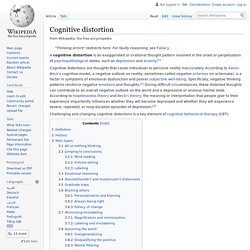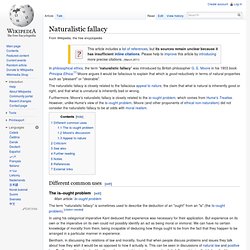

Cognitive distortion. Psychiatrist Aaron T.

Beck who laid the groundwork for research on cognitive distortion. An exaggerated or irrational thought pattern involved in the onset and perpetuation of psychopathological states Challenging and changing cognitive distortions is a key element of cognitive behavioral therapy (CBT). Definition[edit] Cognitive comes from the Medieval Latin cognitīvus, equivalent to Latin cognit(us), 'known'.[5] Distortion means the act of twisting or altering something out of its true, natural, or original state.[6] History[edit] In 1957 Albert Ellis, though he did not know it yet, would aid cognitive therapy in correcting cognitive distortions and indirectly helping David D.
When Burns published Feeling Good: The New Mood Therapy, it made Beck's approach to distorted thinking widely known and popularized.[13][14] Burns sold over four million copies of the book in the United States alone. Main types[edit] Tinkerbell effect. The Tinkerbell effect is an American English expression describing things that are thought to exist only because people believe in them.

The effect is named for Tinker Bell, the fairy in the play Peter Pan who is revived from near death by the belief of the audience. See also[edit] References[edit] External links[edit] Vsauce, How Much Money is there on Earth? Wisdom of repugnance. Origin and usage[edit] The term "wisdom of repugnance" was coined in 1997 by Leon Kass, chairman (2001–2005) of the President's Council on Bioethics, in an article in The New Republic,[3] which was later expanded into a further (2001) article in the same magazine,[4] and also incorporated into his 2002 book Life, Liberty, and the Defense of Dignity.[5] Kass stated that disgust was not an argument per se, but went on to say that "in crucial cases...repugnance is the emotional expression of deep wisdom, beyond reason's power fully to articulate it.

" The term remains largely confined to discussions of bioethics, and is somewhat related to the term "yuck factor". However, unlike the latter, it is used almost exclusively by those who accept its underlying premise; i.e., that repugnance does, in fact, indicate wisdom. It is thus often viewed as loaded language, and is primarily used by certain bioconservatives to justify their position. Criticism[edit] See also[edit] Fallacy. A fallacy is the use of poor, or invalid, reasoning for the construction of an argument.[1][2] A fallacious argument may be deceptive by appearing to be better than it really is.

Some fallacies are committed intentionally to manipulate or persuade by deception, while others are committed unintentionally due to carelessness or ignorance. Fallacies are commonly divided into "formal" and "informal". A formal fallacy can be expressed neatly in a standard system of logic, such as propositional logic,[1] while an informal fallacy originates in an error in reasoning other than an improper logical form.[3] Arguments containing informal fallacies may be formally valid, but still fallacious.[4] Naturalistic fallacy. In philosophical ethics, the term "naturalistic fallacy" was introduced by British philosopher G.

E. Moore in his 1903 book Principia Ethica.[1] Moore argues it would be fallacious to explain that which is good reductively in terms of natural properties such as "pleasant" or "desirable". The naturalistic fallacy is closely related to the fallacious appeal to nature, the claim that what is natural is inherently good or right, and that what is unnatural is inherently bad or wrong. Furthermore, Moore's naturalistic fallacy is closely related to the is–ought problem, which comes from Hume's Treatise. However, unlike Hume's view of the is–ought problem, Moore (and other proponents of ethical non-naturalism) did not consider the naturalistic fallacy to be at odds with moral realism. Different common uses[edit] The is–ought problem[edit] The term "naturalistic fallacy" is sometimes used to describe the deduction of an "ought" from an "is" (the Is–ought problem).